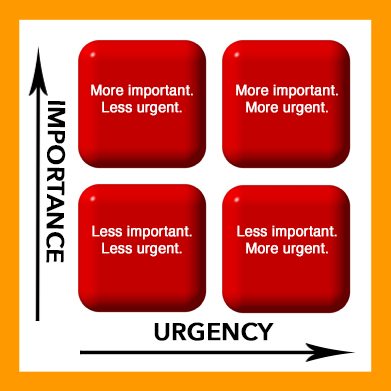
The most successful managers/leaders are excellent at managing their own attention spans. They don’t maintain priority lists that number in the double digits. The dictionary definition of “priority” is a “thing regarded as more important than others.” It is not a plural. Nor is importance the sole criterion for prioritization. Much of what you learn in school and hear from colleagues and employers is that everything you do in life and work is important. However, if you view everything that’s important as a priority, then nothing is a true priority and, even worse, nothing will get done.
The process of prioritization, and determining where to direct your attention, constitutes a balance between importance and urgency. Sometimes the littlest things become the most urgent — and hence have the highest priority. Conversely, sometimes the big things are less urgent and can move down on the priority scale.
Here’s a useful exercise developed by Stephen Covey, author of The 7 Habits of Highly Effective People, to keep your attention focused on the right activities. Draw a square and divide it into equal quadrants. Outside the box draw a vertical axis labeled “Importance” and a horizontal axis labeled “Urgency.” Write down your top ten so-called priorities and plot them into the appropriate quadrant.
If everything falls into the top right-hand quadrant, divide that quadrant into quarters and re-plot.
As activities are completed, remove them from the graph, but note where they were located. If you’re completing more items in the lower left-hand quadrant, you may be more concerned with checking-off items as completed rather than focusing on the truly important activities that will move your career and company forward.
Pay attention to where you’re paying attention.
20/20 Mind Sight is now available for purchase. Multi copy discounts are also available here.






